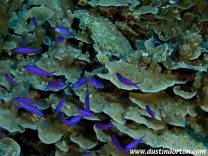
The Marshall Islands (RMI) is one of the four coral nations in the world offering some of the best and most remote diving in worldwide.
| Inserted/Added by: | lars, © Author: Lars Hemel |
| Rated: | Rated 2.0, 4 votes |
Send us your images for this dive region[Add Image][Add Movie]
The Republic of the Marshall Islands (RMI) are a set of 29 atolls and 5 low-lying islands in the central Pacific between Hawaii and Australia. It is the most eastern island group of Micronesia just north of Kiribati. These 29 atolls are formed out of more than 1200 flat low lying coral islands. They are often separated in two groups (Ratak Chain, meaning Sunrise and Ralik Chain, meaning Sunset) and were declared a nation in 1979 and independent in 1986. The most popular and easily reached atolls are Majuro Atoll, Bikini Atoll, Rongelap Atoll, Mili Atoll, Kwajalein Atoll and Arno Atoll. Besides these well known atolls, there are many others with dive potential beyond imaginations. Likiep (Purse of Treasures), Wotje, Maloelap, Enewetok, Rongerik and Jaluit Atoll are all becoming more and more popular with many dive sites yet to be discovered.
Something most vacationers visit this island chain for are its pretty secluded beaches, glorious palm trees and its relaxed lounging around its shores with a cocktail and a book. Water activities such as kayaking, sport fishing, swimming, scuba diving and snorkeling are highlights for all visitors. Other popular tourist attractions at the Marshall Islands are several interesting museums and the ancient culture of the indigenous Marshallese people. Season wise, it is best to plan a visit between December and April when the humidity is low, rain is virtually absence and temperatures are still tropical and mild with cool breezes from the ever blowing Trade Winds. Economically, the Marshall Islands are living from fishing, copra and there is strong support for tourism development.
Scuba diving is obviously one of the top attractions in the Marshall Islands. This land of atolls with its pretty white beaches and pristine underwater world is home to many fish and coral species. With a landmass less than one percent of its total area, situated around the equator, it is a scuba wonder to behold. You can visit spectacular caves, interesting historic WWII wrecks, steep drop-offs, rich coral formations and shallow lagoons brilliant for snorkelers. Pelagic species are common, coral reef fish are numerous and invertebrate and coral life is extremely healthy. It is a divers dream and paradise.
[Add Message]Messages from readers:
[Add Divelog]Divelogs from members:
